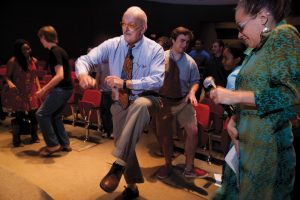Here is a short video describing the Ifa Divination System:
Author Archives: Vicki Brennan
Adara by Orlando Julius Ekemode
Class Notes: Week Four
Link for the Week Four Class Notes document:
ASSIGNMENT: Oṣun-Oṣogbo Festival Reflection
Film Reflection: DUE FRIDAY, SEPTEMBER 15 BY 11:59 PM
FIRST: View the film Sacred Journeys with Bruce Feiler: “Oṣun-Oṣogbo.” You can access it online through the library here:
http://voyager.uvm.edu/vwebv/holdingsInfo?bibId=4007883
Note: You must be connected to the UVM network (either through an on-campus connection or logged in via proxy to stream the video).
As you watch the film be sure to take note of how the film connects to our class readings and discussions so far. Consider the following questions:
- In what way is Oṣun-Oṣogbo festival an example of an African diaspora religion? What specific people, events, or objects make you think that?
- How do terms of religious mixture (such as syncretism or hybridity) help to make sense of the Oṣun-Oṣogbo festival as depicted in the film? What examples of mixture can you identify (if any)?
- How does the Oṣun-Oṣogbo Festival fit into Thompson’s discussion of “the altar concept”?Think about how Thompson’s claims about Afro-Atlantic altars—his emphasis on divine focus, elevation, and the overcoming of time/space distinctions through religious ritual—are evident in the Oṣun-Oṣogbo festival. Pay careful attention to the spaces where the festival takes place, the varying levels of participation for different people who attend the festival engage in, and the actions that those participants engage in as part of the festival.
SECOND: Write a short (500 words) reflection on the film that addresses ONE of the above questions. While you are encouraged to be exploratory in your discussion (in other words, you do not need to write a definitive answer, but you can instead explore possible answers to the question), your reflection should include a specific example from the film as well as a direct quote from (at least) one of our class readings. Most importantly, your reflection should demonstrate your own thoughts and opinions about the film and how it connects to what we have been reading about and discussing in class.
You do not need to provide a “works cited” section or a bibliography for your post, but you should indicate the author of the reading(s) cited and the page number on which the quote is located in your reflection.
THIRD: Post your reflection to the class blog by 11:59pm on Friday, September 15!
To post to the blog you need to log in and access the “Dashboard” for our blog. Click on “Posts” and then on “Add New” to create a blog entry. You can then cut and paste your reflection into the box. Be sure to add a title for your reflection, and select the “Reflections” category for your post. Then hit “Publish.” If you have any problems adding your reflection to the blog, email Professor Brennan ASAP!
Note: this short reflection will be revised and expanded next week and a final formal draft submitted as your first writing assignment for the class.
“Professor of Mambo”
Here is an article about Robert Farris Thompson, the author of our class text book. Read the article to learn more about his research on Afro-Atlantic art and culture, his approach towards studying the Black Atlantic, and his teaching style.
Thompson’s central contribution to his field has been his insistence on understanding African art in context, understanding what it communicates on its home turf. Because of Thompson’s keen interest in context, his take on art history encompasses not only visual art and architecture, but also anthropology, language, religion, ethnomusicology, dance history, and philosophy. His aim, says one former PhD student, is to map “the artistic geography of the African world”; another says that Thompson studies “the diversity of blackness, of blacknesses.” Cornel West, who teaches African American studies at Princeton, calls this white man from Texas “my dear brother” and “one of the greatest pioneers in the study of Afro-American culture and African culture.”
Thompson wants his students to recognize how aspects of African cultures infuse not only the music, art, and dance of the Americas, but also philosophy, religious practice, textile design, everyday gestures, and even vocabulary as quotidian as Uh-huh (yes) and Unh-unh (no). According to David Doris ’02PhD, a professor of African art history at the University of Michigan, “He coined the term that became prevalent in academia: ‘Black Atlantic.’” Says Thompson, “We can’t know how American we are unless we know how black we are.”
Read more at the following link: Professor of mambo
Afro-Cuban Jazz
Chano Pozo:
Afro-Cuban songs for the Oricha:
Class Notes: Week Three
Link for the Week Three Class Notes document. Be sure to follow all instructions in the document to complete this week’s notes:
Class Notes: Week Two
Link for the Week 2 Class Notes Document:
Class Notes for August 31
Link for the class notes document.
Imagining Black Atlantic Religions
https://vimeo.com/203941448
Pat Robertson blames Haitian earthquake on “pact with the devil.”
Miami Herald: How ritual chicken sacrifices in Miami helped halt Trump’s travel ban
